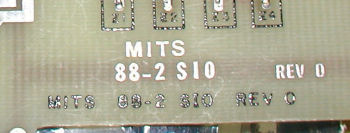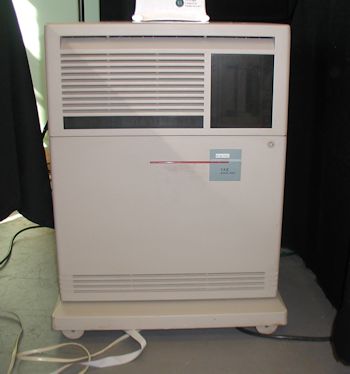MITS 88-2 SIO (2SIO) for BASIC
SHARE |
|
  MITS 88-2 SIO (2SIO) for BASIC
MITS 88-2 SIO (2SIO) for BASIC |
by Bill Degnan - 02/10/2010 22:49 |
 Click image for detailed pictures of jumpers.
Reply |
|
  MITS 88-2 SIO Update
MITS 88-2 SIO Update |
by Bill Degnan - 03/03/2010 02:22 |
|
I re-jumpered the 2SIO card that was pointing to port 000 to 020 and installed it into my Altair 8800b.
I have toggled in the 1st stage loader from the manual and I get the expected lights/results. I was able to toggle in the little echo character program to verify that that the card is correctly interfacing on port 020, the standard for MITS I/O and MS BASIC. I found a great web site that walks a person through the process of testing a 2SIO card and downloading programs through it into RAM of the computer including BASIC: http://www.solivant.com/...air_bootloaders&pagen=0 On page 4 or 5 in the bootloaders section it talks about the cause of "MMM's" being printed on the screen during download of a program. This is what's happening to me, the program can't find the RAM location to dump the program. I verified that I do have RAM available in all 64K pages (0000 through FFFF), but I need to run more substantial RAM testing to be sure it's working correctly. I need to check to see where BASIC is being loaded. Per solivant.com I attempted to download just the 2nd stage loader, and I determined that it's not being written into memory correctly, and it bombs around 1300 bytes into the import consistently. It may be that the RAM I am using is not compatible with the tape download, or it's protecting the addresses I need to write to. I also have a MITS PROM card with MBL PROM which has different switch settings than the toggled-in version, which leads me to think that they're different. Using this loader I attempted to emulate the papertape load of just the BASIC 3.2 code, but I get no response from the computer. I *think* I have the correct switches set before running this version of the loader. Next - I will test the RAM and if necessary plop the cards into a different computer. Reply |
|
  Success - 4K BASIC on Atlair 8800b
Success - 4K BASIC on Atlair 8800b |
by Bill Degnan - 05/11/2010 19:53 |
|
Altair BASIC 3.2 unidentified program listing display.
Finally. Took out all but 16 K MITS RAM card. Installed a bus terminator card. Made sure everything was plugged in securely. Confirmed that the bootstrap loader on Solivant.com matched the bootstrap (page 99) from the Altair BASIC manual. Here is a simple test program: 10 FOR K = 1 TO 1000 20 PRINT K " "; 30 NEXT K 40 END whew! Card cage view, Altair 8800b running 2SIO and 16K MITS RAM. Reply |
|
  TIPS for Loading MITS 4K BASIC 3.2
TIPS for Loading MITS 4K BASIC 3.2 |
by Bill Degnan - 11/25/2011 08:51 |
|
Here is a supplement to the directions from solivant.com/altair_bootloaders/
Here are a few pointers that will help. 1. You need free RAM available in both 0000 through 3FFF. Make sure you have a RAM card that allows you to use or turn on MWRITE so that you can toggle in the bootstrap loader using the front panel. 2. Set your terminal for 8/n/1 to toggle in the following 1st stage bootstrap loader into the Altair from 000 000 000 000: 000: 076 003 323 020 076 025 323 020 010: 041 256 017 061 032 000 333 020 020: 017 320 333 021 275 310 055 167 030: 300 351 013 000 (page 99 of the MITS BASIC manual) 3. From TeraTerm set the character and line transmit delay to 32 msec/char (per Dan Roganti). This setting is found in the setup menu's serial port settings area. This will slow down the download rate, but it will also ensure the data is transferred error-free. The delay may be necessary if you are using a modern serial adapter that buffers the transmission not necessarily a 2sio card thing. 4. Your code is toggled in and tested. Examine 000 000 000 000 (all switches down). If OK, then raise two switches, A11 and A10, (these have a special job called sense switches). Toggle RUN down (I find I don't need to reset first). The lights will change and the computer will now waiting for a "tape" to be sent to it. From TeraTerm File menu send the "tape" file 4k BASIC with bootloader as follows: Open the Send File command from within the File menu. Check "binary." Locate the 4K BASIC file you just downloaded to your hard drive and click "Open". A dialog box will pop up to display the progress of the download. Watch the lights on the computer. At about byte 1300 or so of the download note that the lights on the front of the Altair will change. If at this point the terminal sends a long string of MMMMM characters to the screen, this means that the RAM was not writable, not working, or not present. Stop the process and resolve. On the bright side, if you see the MMMM characters on your terminal you at least know the 2SIO card is working. 5. The solivant.com directions do not tell this: After the last byte of 4K BASIC has been sent, AND if you used the 32 msec delay, the system may freeze for 15 seconds or so while the data stream completes. Watch after this period for the lights on the front panel to change. THEN you'll see a partially garbled MEMORY SIZE? message. (If the lights change but nothing appears on your screen try pressing RUN. If that fails, check 0000 - 2000 to see what's there and if something downloaded at all.) 6. Change the serial communications settings to 7/n/1 to clean up the bad characters, have fun! See solivant.com for more info. 7. If at any time you want to reset BASIC, hit STOP/Reset/RUN to return to the OK prompt. Reply |
|
  Running BASIC Programs on Altair 8800
Running BASIC Programs on Altair 8800 |
by Bill Degnan - 07/21/2012 00:19 |
|
The MITS BASIC manual describes hints about how to convert non-MITS BASIC programs for use on the Altair.
Page 62 of MITS Altair BASIC manual has tips for converting BASIC programs not written for MBASIC (Microsoft). If you're using TERATERM to download BASIC programs into the Altair via a serial card, set the transmit delay to at least 50 msec per character and 150 msec per line. Reply |
|
  IMSAI and 2SIO - Loads 4K BASIC
IMSAI and 2SIO - Loads 4K BASIC |
by Bill Degnan - 12/15/2012 20:37 |
|
And if you're wondering, you can also use an IMSAI 8080 to load BASIC using the MITS 2SIO using this same procedure.
Reply |
|
Resources:

Popular Topics and FAQs
Past Issues:
Before we switched over to a blog format, past page archives here:
Vintage Computer Festival East 3.0 June 2006
Commodore B Series Prototypes July 2006
VOLSCAN - The first desktop computer with a GUI? Oct 2006
ROBOTS! - Will Robots Take Over? Nov 2006
Magnavox Mystery - a Computer, or? Jan 2007
The 1973 Williams Paddle Ball Arcade Computer Game Feb 2007
The Sperry UNIVAC 1219 Military Computer May 2007
VCF East 2007 - PET 30th Anniversary June/July 2007
The Electronic Brain August 2007
Community Memory and The People's Computer Company October 2007
Charles Babbage's Calculating Machine December 2007
Vintage Computing - A 1983 Perspective February 2008
Laptops and Portables May 2008
From Giant Brains to Hobby Computers - 1957 to 1977 August 2008
Historic Computer Magazines November 2008
World's Smallest Electronic Brain - Simon (1950) December 2008 - Feb 2009
Free Program Listings Spring 2009
Computer Music Summer 2009
Popular Electronics Jan/Feb 1975 - Altair 8800 Fall 2009
Early Microcomputer Mass Storage Summer 2010
DEC VAX 4000 200

This image was selected at random from the archive. Click image for more photos and files from this set.